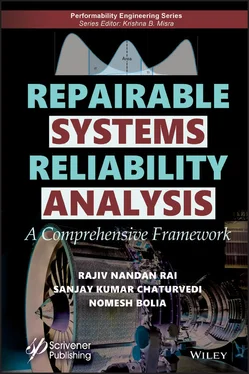This book presents modified failure modes and analysis (FMEA) model in Chapter 6. This model is based on the concept of REI propounded by Kijima and is best applicable to the repairable systems reliability analysis.
Chapter 7provides an integrated approach for weapon procurement systems for military aviation. The combined applications of MCDM tools like AHP, ANP, and optimization techniques can be seen in this chapter. This model can be used for other industries procurement policy as well.
Chapter 8is aimed at reducing the overhaul time of a repairable equipment to enhance the availability. Various concepts of throughput analysis have been utilized in this chapter.
The book makes an honest attempt to provide a comprehensive coverage to various models and methodologies that can be used for modeling and analysis of repairable systems reliability analysis. However, there is always a scope for improvement and we are looking forward to receiving critical reviews and/or comments of the book from students, teachers, and practitioners. We hope that the readers will all gain as much knowledge, understanding, and pleasure from reading this book as we have from writing it.
| Table 2.1 |
Rotating machine failure data of Example 2.2 |
| Table 2.2 |
MCF and confidence calculations |
| Table 2.3 |
Example 2.3—Burn-in period determination |
| Table 2.4 |
Data for Example 2.4 |
| Table 2.5 |
List of failure categories and counts for all 53 ROVs |
| Table 2.6 |
Failure Counts in Months Corresponding their Failure Modes |
| Table 2.7 |
MCF calculation by combining all failure modes |
| Table 2.8 |
MCF calculation for individual category at 24 months |
| Table 2.9 |
A sample of collected data |
| Table 2.10 |
Exercise 1: Failure data of three systems |
| Table 3.1 |
Time to failure data (hours) of aero engines of Example 3.2 |
| Table 3.2 |
Virtual age–based reliability metrics |
| Table 3.3 |
Time to failure data (hours) of Example 3.4 |
| Table 3.4 |
Time to failure data (hours) of Example 3.5 |
| Table 3.5 |
Time between failures for a compressor |
| Table 4.1 |
Hypothesis tests |
| Table 5.1 |
Maintenance modeling in repairable systems |
| Table 5.2 |
Relative outcome of the two overhaul cycles |
| Table 5.3 |
Relative outcome of the two overhaul cycles |
| Table 5.4 |
Comparative results of both overhaul cycles (Variant 1) |
| Table 5.5 |
Comparative results of both overhaul cycles (Variant 2) |
| Table 5.6 |
Results-failure mode wise for first overhaul cycle |
| Table 5.7 |
Results-failure mode wise for t 2OH |
| Table 5.8 |
Failure mode wise percent improvement |
| Table 5.9 |
Comparative results of both overhaul cycles for the aero engine |
| Table 6.1 |
Extensions to standard FMEA |
| Table 6.2 |
Failure cause-mode effect relationship |
| Table 6.3 |
Severity rating |
| Table 6.4 |
Occurrence rating |
| Table 6.5 |
Failure mode wise initial RPN |
| Table 6.6 |
Failure mode wise values of final Q |
| Table 6.7 |
Final RPNs |
| Table 6.8 |
FM1 |
| Table 6.9 |
FM2 |
| Table 6.10 |
FM3 |
| Table 6.11 |
Comparative results |
| Table 7.1 |
Brief literature review on WSCE using MCDM |
| Table 7.2 |
Weights for API |
| Table 7.3 |
Actual and scaled API values of each weapon category |
| Table 7.4 |
APV estimation of combat force “ALPHA” |
| Table 7.5 |
APV enhancement |
| Table 7.6 |
API ijvalues |
| Table 7.7 |
C ij(million USD), a i, d i, and m i |
| Table 7.8 |
A ijvalues |
| Table 7.9 |
Optimal x ijvalues |
| Table 8.1 |
Brief literature review on TH analysis |
| Table 8.2 |
Required TH of the three components |
| Table 8.3 |
Process requirements of LPCR blades repair |
| Table 8.4 |
Process requirements of CCOC repair |
| Table 8.5 |
Process requirements of LPTR blades repair |
| Table 8.6 |
Component 1—LPCR blades |
| Table 8.7 |
Component 2—CCOC |
| Table 8.8 |
Component 3—LPTR blades |
| Figure 1.1 |
Types of repair |
| Figure 1.2 |
Various techniques for reliability analysis |
| Figure 2.1 |
A MCF example |
| Figure 2.2 |
An improving system |
| Figure 2.3 |
A stable system |
| Figure 2.4 |
A deteriorating system |
| Figure 2.5 |
History and distribution of failures observed at age t |
| Figure 2.6 |
MCF plot of Example 2.2 |
| Figure 2.7 |
Graphical plots of Example 2.3 |
| Figure 2.8 |
MCF with confidence bounds of Example 2.2 data |
| Figure 2.9 |
MCF plot of Example 2.4 |
| Figure 2.10 |
A ROV. (Image taken from: https://www.pinterest.com/pin/552676185495210644/?nic=1) |
| Figure 2.11 |
MCF by combining all failure modes |
| Figure 2.12 |
Event plot for each system |
| Figure 2.13 |
MCF plot of each system |
| Figure 2.14 |
Grouping of systems based on performance behavior |
| Figure 2.15 |
Event plot of all three groups |
| Figure 2.16 |
MCF plot of all three groups |
| Figure 3.1 |
Bathtub-shaped intensity function |
| Figure 3.2 |
Conditional probability of occurrence of failures |
| Figure 3.3 |
Photograph of an aero engine |
| Figure 3.4 |
Intensity function plot for Example 3.1 |
| Figure 3.5 |
Intensity function plot for Example 3.2 |
| Figure 3.6 |
Intensity function plot for Example 3.3 |
| Figure 3.7 |
Availability plot for Example 3.3 |
| Figure 5.1 |
Reliability-based HFRC threshold |
| Figure 5.2 |
Availability-based threshold for HFRC |
| Figure 5.3 |
Flying task vs. availability |
| Figure 6.1 |
q vs. F(v i| v i–1) for FM1 |
| Figure 6.2 |
q vs. F(v i| v i–1) for FM2 |
| Figure 6.3 |
q vs. F(v i| v i–1) for FM3 |
| Figure 7.1 |
Overview of the approach |
| Figure 7.2 |
Evaluation of alternatives through ANP |
| Figure 7.3 |
Evaluation of APE through AHP |
| Figure 8.1 |
Overview of Chapter 8 |
| Figure 8.2 |
Propagation of variability between workstations in series |
| Figure 8.3 |
Work flow/work stations for engine overhaul line |
| Figure 8.4 |
Work flow/work stations for LPCR blades |
| Figure 8.5 |
Work flow/work stations for CCOC |
| Figure 8.6 |
Work flow/work stations for LPTR blades repair |












